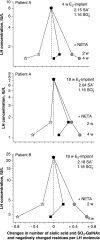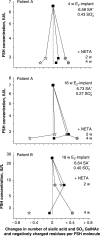Effects of 17beta-oestradiol and norethisterone acetate on sulfonation and sialylation of gonadotrophins in post-menopausal women
- PMID: 20141368
- PMCID: PMC2853786
- DOI: 10.3109/03009730903573253
Effects of 17beta-oestradiol and norethisterone acetate on sulfonation and sialylation of gonadotrophins in post-menopausal women
Abstract
Background: The number of terminal sialic acid and sulfonated N-acetylgalactosamine (SO(3)-GalNAc) on gonadotrophins in serum varies during the menstrual cycle and changes at menopause, suggesting that gonadal steroids modify their oligosaccharide synthesis. Our objective was to determine the effects of 17beta-oestradiol (E(2)) and a progestogen, norethisterone acetate (NETA), on the sulfonation and sialylation of gonadotrophins in post-menopausal women.
Methods: Serum samples were obtained from eight post-menopausal women treated with 20 mg E(2) implants every 6 months, from four women who in addition were treated daily with 5 mg NETA orally for a 2-week period, and from four women who got this NETA treatment during a 4-week period. Sera from 11 non-treated post-menopausal women served as a reference group. The gonadotrophin serum concentrations, the number of SO(3)-GalNAc and sialic acid residues per serum luteinizing hormone (LH) and follicle-stimulating hormone (FSH) molecule, and the distributions of molecules with 0-1-2-3-4 sulfonated residues were measured.
Results: The E(2)-treated post-menopausal women had considerably less (P < 0.001) sialic acid and slightly more (P < 0.01) SO(3)-GalNAc per serum LH and FSH molecule than the non-treated. Two weeks of NETA treatment increased the sulfonation of LH (P < 0.01) and FSH (P < 0.05) concomitantly with decreased (P < 0.05) sialylation of LH.
Conclusion: The primary effect of E(2) treatment was a decrease in sialylation and, due to competition for the same substrate, a secondary and consequentially minor increase in sulfonation of LH and FSH. The primary effect of the NETA therapy was an increase in the sulfonation of LH and FSH concomitantly with secondary and consequentially decreases in sialylation of LH.
Figures




Similar articles
-
Time-related effects of a progestogen on the isoforms of serum gonadotrophins in 17 beta-oestradiol treated post-menopausal women.Clin Endocrinol (Oxf). 1996 Jun;44(6):651-8. doi: 10.1046/j.1365-2265.1996.748569.x. Clin Endocrinol (Oxf). 1996. PMID: 8759177
-
Effect of chronic daily oral administration of 17 beta-oestradiol and norethisterone on the isoforms of serum gonadotrophins in post-menopausal women.Clin Endocrinol (Oxf). 1995 Jan;42(1):59-64. doi: 10.1111/j.1365-2265.1995.tb02599.x. Clin Endocrinol (Oxf). 1995. PMID: 7889633
-
Sulfonation and sialylation of gonadotropins in women during the menstrual cycle, after menopause, and with polycystic ovarian syndrome and in men.J Clin Endocrinol Metab. 2007 Nov;92(11):4410-7. doi: 10.1210/jc.2007-1342. Epub 2007 Aug 21. J Clin Endocrinol Metab. 2007. PMID: 17711919
-
Effects of tibolone and combined 17beta-estradiol and norethisterone acetate on serum C-reactive protein in healthy post-menopausal women: a randomized trial.Hum Reprod. 2002 Oct;17(10):2748-53. doi: 10.1093/humrep/17.10.2748. Hum Reprod. 2002. PMID: 12351557 Clinical Trial.
-
Correlation between the serum norethindrone (NET) levels attained after insertion of a silastic implant releasing norethindrone acetate and the endogenous hormones particularly progesterone.Contraception. 1981 Feb;23(2):211-25. doi: 10.1016/0010-7824(81)90106-2. Contraception. 1981. PMID: 6786828
Cited by
-
Dynamic changes in glycosylation and glycan composition of serum FSH and LH during natural ovarian stimulation.Ups J Med Sci. 2013 Aug;118(3):153-64. doi: 10.3109/03009734.2013.782081. Epub 2013 Mar 25. Ups J Med Sci. 2013. PMID: 23527482 Free PMC article.
-
Gonadotropin Glycoforms Circulating in Women Using Progestins of the Levonorgestrel Family for Contraception.J Endocr Soc. 2020 Aug 28;4(11):bvaa128. doi: 10.1210/jendso/bvaa128. eCollection 2020 Nov 1. J Endocr Soc. 2020. PMID: 33123654 Free PMC article.
References
-
- Wide L. Median charge and charge heterogeneity of human pituitary FSH, LH and TSH. II. Relationship to sex and age. Acta Endocrinol (Copenh) 1985;109:190–7. - PubMed
-
- Wide L, Naessén T, Sundström-Poroma I, Eriksson K. Sulfonation and sialylation of gonadotropins in women during the menstrual cycle, after menopause, and with polycystic ovarian syndrome and in men. J Clin Endocrinol Metab. 2007;92:4410–7. - PubMed
-
- Green ED, Baenziger JU. Asparagine-linked oligosaccharides on lutropin, follitropin, and thyrotropin. II. Distributions of sulfated and sialylated oligosaccharides on bovine, ovine, and human pituitary glycoprotein hormones. J Biol Chem. 1988;263:36–44. - PubMed
-
- Wilson CA, Leigh AJ, Chapman AJ. Gonadotrophin glycosylation and function. J Endocrinol. 1990;125:3–14. - PubMed
-
- Wide L. Male and female forms of human follicle-stimulating hormone in serum. J Clin Endocrinol Metab. 1982;55:682–8. - PubMed
Publication types
MeSH terms
Substances
LinkOut - more resources
Full Text Sources
